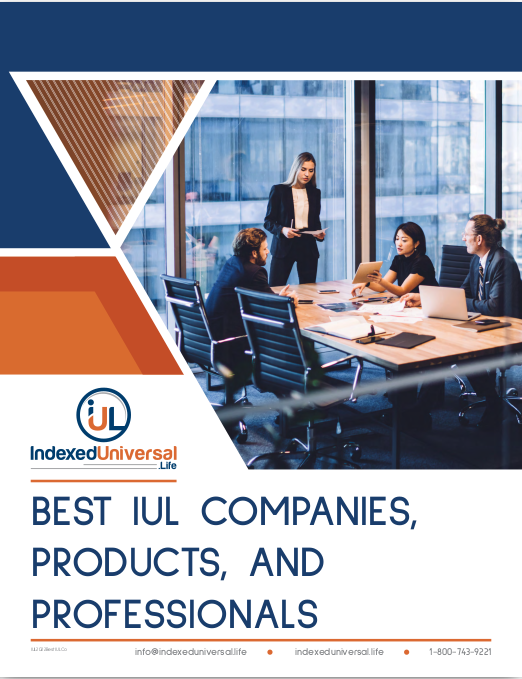
Key Takeaways
-
Indexed Universal Life (IUL) policies provide flexible life insurance with potential cash-value growth linked to market indexes, offering moderate risk and returns.
-
Variable annuities are investment products designed primarily for retirement, allowing you to invest in market-based funds with higher growth potential but also higher risk.
Understanding Indexed Universal Life (IUL)
When considering your financial future, life insurance often plays a key role. One popular option that might pique your interest is Indexed Universal Life, or IUL. Think of it as a hybrid financial tool combining life insurance protection with investment-like growth potential.
How Indexed Universal Life Works
IUL policies offer life insurance coverage while allowing you to accumulate cash value. The unique twist? Your cash value’s growth depends partly on the performance of a market index, like the S&P 500.
Here’s what you need to know:
-
Cash value growth: Gains are based on a market index, providing opportunities for market-linked returns without direct investment.
-
Floor and caps: Most IULs come with guaranteed minimum returns (floors), protecting against market downturns. However, they also impose caps limiting your maximum returns in strong market years.
-
Premium flexibility: You have the option to adjust your premium payments within policy limits, which can help if your financial situation changes over time.
Advantages of IUL
An IUL offers several key advantages:
-
Tax-advantaged growth: Your cash value accumulates on a tax-deferred basis, meaning you don’t pay taxes on earnings until withdrawal.
-
Market upside with protection: The built-in floor means you won’t lose money due to market downturns, providing peace of mind.
-
Death benefit flexibility: You can adjust your death benefit to align with changing financial goals or life stages.
Potential Drawbacks of IUL
However, IUL isn’t without some potential downsides:
-
Complex fees: Administrative fees and policy charges can eat into your returns, especially over long durations.
-
Return caps: Your growth potential is limited by predetermined caps, potentially reducing gains during booming markets.
-
Performance dependency: Since returns depend on market indexes, your cash value growth might be unpredictable year-to-year.
Exploring Variable Annuities
On the other side of the fence, variable annuities offer a different path to securing your financial future. These financial products are designed mainly for retirement planning, providing you with potential investment growth coupled with income stability.
How Variable Annuities Work
Variable annuities let you invest your contributions into a variety of market-based funds, similar to mutual funds. These funds can include stocks, bonds, and other securities. The eventual payout you receive depends directly on how your investments perform.
Here’s the breakdown:
-
Investment flexibility: Choose from a variety of funds based on your risk tolerance and retirement timeline.
-
Tax deferral: Like IUL, variable annuities offer tax-deferred growth, meaning you pay taxes only upon withdrawal.
-
Income options: You can choose to receive income immediately or defer payouts until later, offering flexibility in retirement planning.
Advantages of Variable Annuities
Variable annuities come with notable benefits:
-
Higher growth potential: Because you invest directly in the market, your earnings potential can be significantly higher compared to more conservative options.
-
Income guarantees: Many variable annuities offer optional riders guaranteeing a minimum income regardless of market performance, protecting against outliving your savings.
-
Diversification: With multiple investment options available, you can tailor your portfolio to match your goals.
Potential Drawbacks of Variable Annuities
But variable annuities have some noteworthy downsides:
-
Market risk: Your investment value can fluctuate significantly, exposing you to potential losses during market downturns.
-
High fees: Variable annuities often come with higher management fees, mortality and expense charges, and administrative fees, impacting overall returns.
-
Surrender charges: Withdrawing money early, typically within the first several years, often results in hefty surrender fees.
Key Differences to Closely Examine
When comparing IUL and variable annuities, a few key factors can guide your decision.
Risk and Reward Balance
-
IUL: Offers moderate risk with floors limiting potential losses and caps limiting potential gains.
-
Variable Annuities: Higher risk due to direct market investments, but with potentially higher rewards.
Purpose and Timing
-
IUL: Primarily suited as life insurance with supplemental retirement benefits, beneficial during your earning years.
-
Variable Annuities: Primarily a retirement income vehicle, ideally purchased closer to retirement or during peak earning periods.
Fees and Expenses
-
IUL: Fees can be complex but usually moderate; look closely at mortality charges and administrative fees.
-
Variable Annuities: Typically have higher overall fees, including investment management, riders, and surrender charges.
Which One Is Right for You?
Choosing between an IUL and a variable annuity depends significantly on your financial goals, timeline, and risk tolerance.
Consider an IUL if you:
-
Seek life insurance with investment-like cash value growth.
-
Prefer moderate risk with protection from severe market downturns.
-
Desire flexibility in premium payments and death benefits.
Opt for a variable annuity if you:
-
Focus primarily on retirement income rather than life insurance.
-
Are comfortable with market volatility for potentially greater returns.
-
Seek guaranteed income options to supplement Social Security or pension benefits.
Frequently Asked Questions (FAQs)
Can you lose money with an Indexed Universal Life policy?
Technically no, due to the policy’s guaranteed minimum return. However, administrative fees can reduce your accumulated cash value.
Are variable annuities guaranteed?
Only certain riders guarantee minimum income or death benefits. Without these riders, your returns fluctuate with market performance.
How long should you keep a variable annuity?
Generally, variable annuities are long-term investments, often 10 to 20 years, to benefit from tax deferral and overcome initial fees.
Can I withdraw from an IUL policy?
Yes, but withdrawals can affect your policy’s death benefit and may have tax implications if exceeding the policy basis.
Making Your Financial Decision Easier
The choice between an IUL and a variable annuity boils down to understanding your personal goals. If you’re more focused on insurance protection with some growth, an IUL can be appealing. Conversely, if your primary concern is building retirement savings with market exposure and potential higher returns, a variable annuity may better suit your needs.
Given the complexity and long-term nature of both options, it’s crucial to consult with a licensed financial advisor who can provide guidance tailored to your unique situation. An advisor can explain these products clearly, ensuring you make an informed choice aligned with your financial ambitions.





